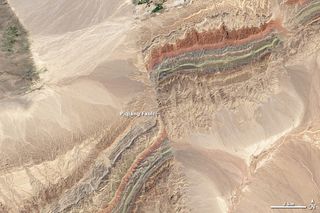Amazing Image of Colorful Rocks Wins NASA Photo Contest

A powerful portrait of plate tectonics took the top prize this year in NASA's annual photo contest, called Tournament Earth.
In Tournament Earth, people vote online for the best images from NASA's Earth Observatory, a website where the space agency's data-crunchers and shutterbugs display their finest images of Earth. The head-to-head battle runs at the same time as the March Madness college basketball playoffs.
The contest includes categories such as events, data, photos and art, and the 32 top images represent some of the best pictures of Earth that NASA offers the public. This year, the competition included incredible mosaics of Amazon critter habitats, photos of Central Asia's drying Aral Sea and a spotlight on the sharp boundary between China and Kazakhstan. Astronauts aboard the International Space Station grabbed the top slots in the photo category, for their spectacular shots of lightning and the Earth at night. [Gallery: Top 8 Earth Images for 2015]
But the grand prize this year went to an image of an amazing geologic feature in China's Xinjiang province. It’s the first win ever to come from the workhorse Landsat satellite program, which added its eighth and most advanced satellite in 2013. (The first Landsat satellite launched in 1972.)
The winning image captures rainbow-colored ridges near the foothills of the Tian Shan mountains, in northwestern Xinjiang. The tortured rocks are more than 350 million years old, and have been squeezed and sliced like kid's modeling clay. A dramatic cut through the region, by the Piqiang Fault, parts the ridges and divides the scene.
The Xinjiang photo was entered in the art category, making it the second year in a row that the overall winner came from that category. Last year, an artistic scene of the Hawaiian Islands took the top slot.
For all the nominees, visit NASA's Earth Observatory, and check the site in March 2016 to vote in next year's competition.
Sign up for the Live Science daily newsletter now
Get the world’s most fascinating discoveries delivered straight to your inbox.
Follow Becky Oskin @beckyoskin. Follow Live Science @livescience, Facebook & Google+. Originally published on Live Science.

Most Popular

